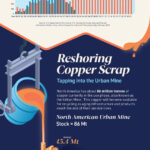Energy News Beat
The following content is sponsored by the Copper Development Association
The State of Copper Recycling in the U.S.
Copper is essential for a low-carbon economy due to its crucial role in renewable energy technologies.
As a result, many worry that a lack of the metal used in wires and batteries can hurt a transition to a green economy.
In this graphic, our sponsor, the Copper Development Association, explores how recycling can address the demand for copper.
Copper Scrap Recycled in the U.S.
In 2022, the total copper scrap recycled in the U.S. was approximately 830,000 tonnes, equivalent to 32% of the total U.S. copper supply for the same period. Around 670,000 tonnes (81%) originated from pre-consumer sources generated during manufacturing operations, while 160,000 tonnes (19%) came from post-consumer sources, such as obsolete products.
Brass and wire-rod mills accounted for the majority of the copper recycled from scrap (85%). Additionally, smelters, refiners, and ingot makers make 10% and chemical plants, foundries, and other manufacturers around 5%.
Copper from Scrap2022 Content (tonnes)
Brass and wire-rod mills650,000 t
Smelters and refiners40,000 t
Ingot makers39,500 t
Foundries, Other40,000 t
Despite the rising demand for copper, the U.S. predominantly exports its copper scrap.
In 2022, the U.S. exported half of the 1,569,000 tonnes of the copper content generated from scrap. This export trend persisted because, until recent years, the country lacked operating secondary copper smelters capable of processing complex scrap grades into furnace-ready raw materials.
However, reshoring this metal presents an opportunity for the country.
Tapping into the Urban Mine
North America currently has about 86 million tonnes (Mt) of copper in use, known as the Urban Mine. This copper will become available for recycling as aging infrastructure and products reach the end of their service lives:
Buildings: 45.4 Mt
Infrastructure: 16.1 Mt
Consumer Products: 11.2 Mt
Transport: 8.5 Mt
Industrial Uses: 4.8 Mt
Increased secondary smelting and refining capacity is a crucial building block for a more resilient and self-sufficient U.S. copper supply chain.
In response to the growing need for copper, the U.S. plans to add over 280,000 tonnes of secondary smelting and refining capacity in the next few years. This expansion will enable the country to process more complex scrap grades domestically.
Given that copper products can last for decades, creating a lag time before the material becomes available for recycling, primary production will continue to play an important role in meeting the increasing needs in the U.S.
The Copper Development Association (CDA) brings the value of copper and its alloys to society to address the challenges of today and tomorrow. Visit www.copper.org to learn more about why copper is a critical mineral.
The post The State of Copper Recycling in the U.S. appeared first on Elements by Visual Capitalist.
ENB Top News
ENB
Energy Dashboard
ENB Podcast
ENB Substack
The post The State of Copper Recycling in the U.S. appeared first on Energy News Beat.








